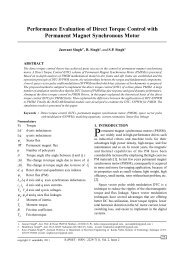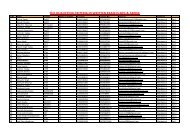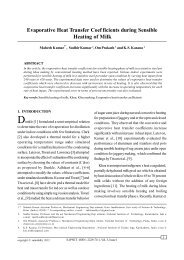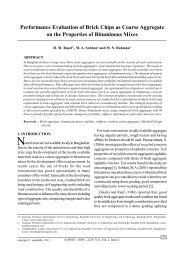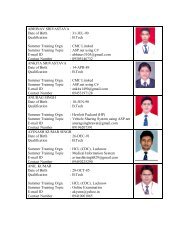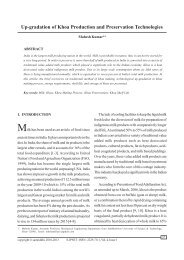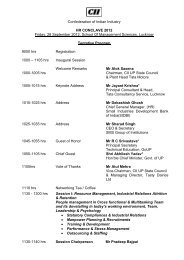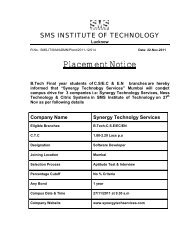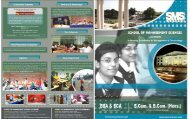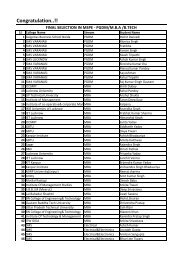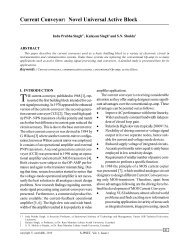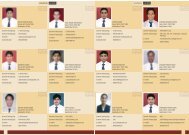Electronics Spectra - SMS Lucknow
Electronics Spectra - SMS Lucknow
Electronics Spectra - SMS Lucknow
You also want an ePaper? Increase the reach of your titles
YUMPU automatically turns print PDFs into web optimized ePapers that Google loves.
<strong>SMS</strong> Institute of Technology, L ucknow<br />
Department of <strong>Electronics</strong> & Co mmunication<br />
advanced programmed Microcontroller<br />
which always tries to deliver exact,<br />
matching amount of power to motor<br />
in 1/100th second, so that Mot or<br />
uninterruptly drives the given load with<br />
less POWER. NN Power Planner Guarantees<br />
ENERGY SAVING up to 9-10%<br />
on MOTORS running partly or on<br />
VARIABLE LOAD. It has also got the<br />
feature of dynamic backstop vo ltage<br />
control, which can be fine tuned from<br />
67% LV to 100% LV for better EN-<br />
ERGY savings.<br />
APPLICATIONS<br />
NN Power Planner can be used on<br />
any application where motor's speed<br />
is constant and motor is runni ng on<br />
variable load or part load for most of<br />
its duty cycle. The best appli cations<br />
where NN Power Planner can be used<br />
are:<br />
1- Injection Moulding Machines<br />
2- Hydraulic Press<br />
3- Suction Rod Pump<br />
Quantum computing<br />
Imagine a computer that calculates<br />
the data 10 times faster than the<br />
computer's processor, like Pentium-4<br />
& core 2 duos, use now-a-days!!<br />
Scientists & researchers are trying<br />
for the development of such hi gh<br />
speed processors that work on the<br />
principle -:<br />
"Atoms are natural calculators”. On<br />
this basis, Quantum computers are developing<br />
in present date.Recen tly,a<br />
great physicist ,Prof Michael De Lyukin<br />
leading a team has got the success of<br />
first entanglement of quantum science<br />
between a solid state material and<br />
photon!!Prof.at Harvard university said<br />
that this achievement is the first step<br />
towards development of practic al<br />
quantum computers.<br />
Via the entanglement of photon<br />
& solid state material only th e solid<br />
state bits or qubits are able to communicate<br />
through a longer dist ance<br />
at a very fast pace.Digital computers<br />
use qubits for all specific operations.<br />
Scientists consider photons as the<br />
fastest medium for transmissio n of<br />
quantum information without an y<br />
loss. Seemingly with these technologies,<br />
our future would be embedded<br />
with turbo boost technology!!A t the<br />
Argonne National Laboratory, P aul<br />
Benioff is credited with first applying<br />
4- Machine Tools<br />
5- Grinders<br />
6- Conveyors<br />
7- Metal Cutters<br />
8- Escalators<br />
9- Crusher<br />
IN SUMMARY IT MEANS<br />
THAT NN POWER<br />
PLANNER WILL<br />
1. Reduces the amount of Current<br />
quantum turning machine.<br />
This superposition of qubits gives<br />
to quantum computers their inherent<br />
parallelism. According to phys icist<br />
David Deutsch, this parallelism allows<br />
a quantum computer to work on a<br />
million computations at once. While<br />
our desktop pc works on one. A 30-<br />
Qubit quantum computer would b e<br />
equal the processing power of a conventional<br />
computer that could run at<br />
10 teraflops(trillions of floating-point<br />
operations per second).Today's typical<br />
desktop computers run at s peed<br />
in gigaflops (billions of floating points<br />
operations per second).<br />
Problems and practicality issues (To<br />
get to quantum computers):-<br />
There are a number of practica l<br />
difficulties in building a quantum computer.<br />
David Di Vincenzo, of IBM, listed<br />
the following requirements for a practical<br />
quantum computer:<br />
‣ Scalable physically to inverse the<br />
number of qubits.<br />
‣ Qubits can be initiated to arbitrary<br />
values.<br />
‣ Quantum gates faster than coherence<br />
time.<br />
‣ Turing-complete gate set.<br />
‣ Qubits can be read easily.<br />
To summarise the problem from<br />
the perspective of an engineer, one<br />
consumed by the motor to do its<br />
job of work.<br />
2. Reduces the high starting and inrush<br />
current while starting.<br />
3. Increases motor life by 50% to<br />
70%.<br />
4. By reducing maintenance costs<br />
and equipment down time improves<br />
motor and plant reliability.<br />
5. It is suitable for a very wide range<br />
of applications.<br />
6. Even to high efficiency motor, it<br />
not only provide superb contro l<br />
over the starting and stopping of<br />
the motor, furthermore it gives an<br />
additional saving in overall energy<br />
consumption by its dynamic control.<br />
7. Its prices are extremely attractive<br />
and competitive.<br />
This device is currently in use and<br />
marketed by NN PROJECT LIMITED ,<br />
a firm based in Gurgaon, Haryana.<br />
<br />
Siddhant Tripathi<br />
EC - II year<br />
needs to solve the challenge of building<br />
a system which is isolated from<br />
everything except the measurem ent<br />
and manipulation mechanism. Further<br />
more, one needs to be able to turn<br />
off the coupling of the qunits to the<br />
measurement so as to not DECO here<br />
the qubits while performing operations<br />
on them.<br />
QUBIT CONTROL<br />
Computer scientists control th e<br />
microscopic particles that act as qubits<br />
in quantum computers by using control<br />
devices.<br />
‣ Ion traps use optical or magnetic<br />
fields (or Opt magnetic field) to<br />
trap ions.<br />
‣ Optical traps use light waves to<br />
trap and control particles.<br />
‣ Quantum dots are made of semiconductor<br />
material and are used<br />
to contain and manipulate elec -<br />
trons.<br />
‣ Semiconductor impurities contain<br />
electrons by using unwanted atoms<br />
found in semiconductor material.<br />
‣ Superconducting circuits allow<br />
electrons to flow with almost no<br />
resistance at low temperatures.<br />
<br />
37 <strong>Electronics</strong> <strong>Spectra</strong>, 2010



